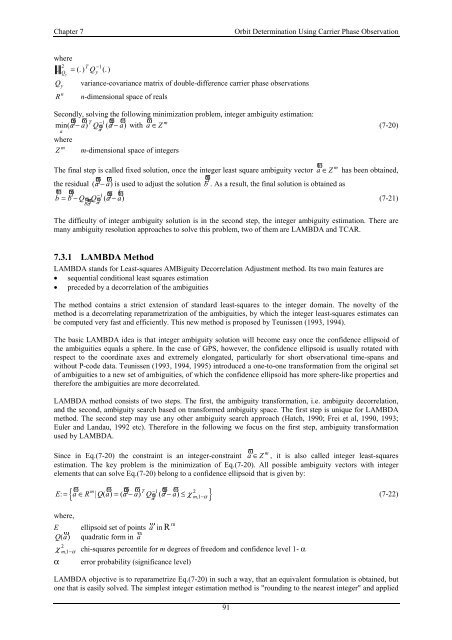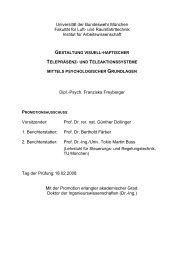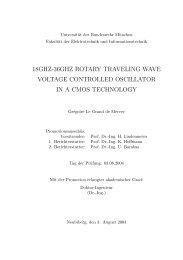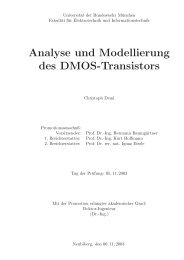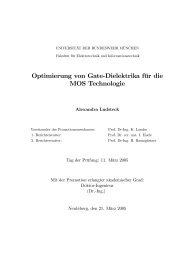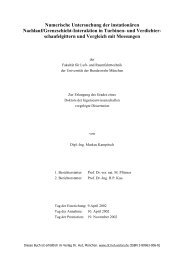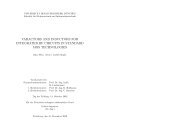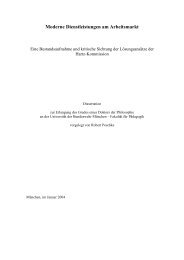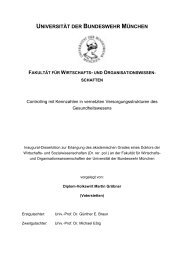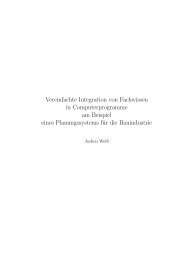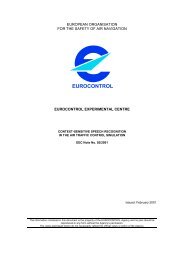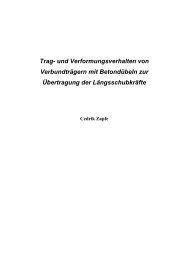Precise Orbit Determination of Global Navigation Satellite System of ...
Precise Orbit Determination of Global Navigation Satellite System of ...
Precise Orbit Determination of Global Navigation Satellite System of ...
You also want an ePaper? Increase the reach of your titles
YUMPU automatically turns print PDFs into web optimized ePapers that Google loves.
Chapter 7 <strong>Orbit</strong> <strong>Determination</strong> Using Carrier Phase Observation<br />
where<br />
2 T −1<br />
Q<br />
y<br />
y<br />
. = (.) Q (.)<br />
Q y<br />
R n<br />
variance-covariance matrix <strong>of</strong> double-difference carrier phase observations<br />
n-dimensional space <strong>of</strong> reals<br />
Secondly, solving the following minimization problem, integer ambiguity estimation:<br />
min( ∃ ) ( ∃ ϖ ϖT −1 ϖ ϖ<br />
a−a Qϖa−a) with ϖ a Z m<br />
∈ (7-20)<br />
a<br />
where<br />
Z m<br />
a∃<br />
m-dimensional space <strong>of</strong> integers<br />
The final step is called fixed solution, once the integer least square ambiguity vector ϖ( m<br />
a ∈ Z has been obtained,<br />
the residual ( ∃ ϖ ϖ(<br />
a−a) is used to adjust the solution ϖ∃ b . As a result, the final solution is obtained as<br />
ϖ( ϖ∃ − ϖ ϖ(<br />
b = b −QϖϖQϖ( a−a ∃ )<br />
(7-21)<br />
∃∃ ba a∃<br />
1<br />
The difficulty <strong>of</strong> integer ambiguity solution is in the second step, the integer ambiguity estimation. There are<br />
many ambiguity resolution approaches to solve this problem, two <strong>of</strong> them are LAMBDA and TCAR.<br />
7.3.1 LAMBDA Method<br />
LAMBDA stands for Least-squares AMBiguity Decorrelation Adjustment method. Its two main features are<br />
• sequential conditional least squares estimation<br />
• preceded by a decorrelation <strong>of</strong> the ambiguities<br />
The method contains a strict extension <strong>of</strong> standard least-squares to the integer domain. The novelty <strong>of</strong> the<br />
method is a decorrelating reparametrization <strong>of</strong> the ambiguities, by which the integer least-squares estimates can<br />
be computed very fast and efficiently. This new method is proposed by Teunissen (1993, 1994).<br />
The basic LAMBDA idea is that integer ambiguity solution will become easy once the confidence ellipsoid <strong>of</strong><br />
the ambiguities equals a sphere. In the case <strong>of</strong> GPS, however, the confidence ellipsoid is usually rotated with<br />
respect to the coordinate axes and extremely elongated, particularly for short observational time-spans and<br />
without P-code data. Teunissen (1993, 1994, 1995) introduced a one-to-one transformation from the original set<br />
<strong>of</strong> ambiguities to a new set <strong>of</strong> ambiguities, <strong>of</strong> which the confidence ellipsoid has more sphere-like properties and<br />
therefore the ambiguities are more decorrelated.<br />
LAMBDA method consists <strong>of</strong> two steps. The first, the ambiguity transformation, i.e. ambiguity decorrelation,<br />
and the second, ambiguity search based on transformed ambiguity space. The first step is unique for LAMBDA<br />
method. The second step may use any other ambiguity search approach (Hatch, 1990; Frei et al, 1990, 1993;<br />
Euler and Landau, 1992 etc). Therefore in the following we focus on the first step, ambiguity transformation<br />
used by LAMBDA.<br />
Since in Eq.(7-20) the constraint is an integer-constraint ϖ a Z m<br />
∈ , it is also called integer least-squares<br />
estimation. The key problem is the minimization <strong>of</strong> Eq.(7-20). All possible ambiguity vectors with integer<br />
elements that can solve Eq.(7-20) belong to a confidence ellipsoid that is given by:<br />
ϖ m ϖ ϖ ϖT − ϖ ϖ<br />
{ ϖ<br />
a∃<br />
m,<br />
− }<br />
1<br />
2<br />
1<br />
E: a R | Q( a) ( a a Q a a<br />
∃ ) ( ∃ = ∈ = − − ) ≤ χ α (7-22)<br />
where,<br />
E ellipsoid set <strong>of</strong> points ϖ Qa ( )<br />
a in<br />
ϖ<br />
quadratic form in ϖ a<br />
R<br />
m<br />
2<br />
χ m,1−α<br />
chi-squares percentile for m degrees <strong>of</strong> freedom and confidence level 1- α<br />
α error probability (significance level)<br />
LAMBDA objective is to reparametrize Eq.(7-20) in such a way, that an equivalent formulation is obtained, but<br />
one that is easily solved. The simplest integer estimation method is "rounding to the nearest integer" and applied<br />
91


